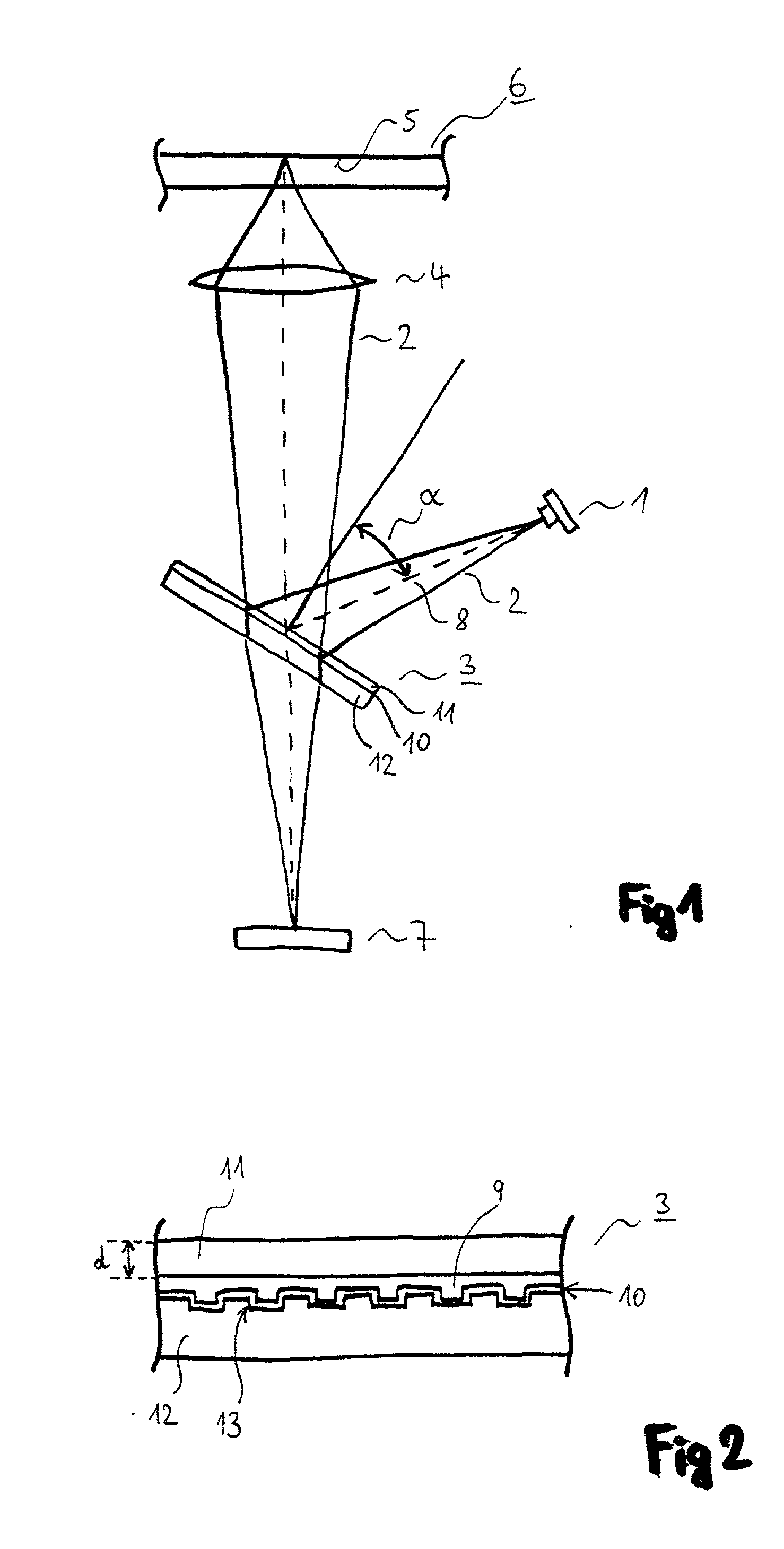[0005] An object of the invention is to improve a device of this type for reading from or writing to
optical recording media, in particular also with regard to reducing the production costs.
[0006] According to the invention, it is provided for this purpose that the semi-transparent mirror is a plane-
parallel plate with a
layered structure, a partially reflective layer being arranged between two small carrier plates. This has the
advantage that the reflective layer is protected by the carrier plates against external influences of a mechanical, chemical or other nature, both before and during the production of the device as well as during its operation.
[0007] According to the invention, it is also envisaged to arrange a
grating structure between the carrier plates. This has the
advantage that a
grating structure which is required in any case in the device, for example for producing primary and secondary scanning beams, or influencing the beam in some other way, for example by a hologram
grating structure, is integrated into the semi-transparent mirror. The grating structure is consequently also protected against external influences. This dispenses with a component which otherwise has to be separately made and installed, and dispenses with the corresponding effort for its adjustment. The grating structure is in this case preferably applied to one of the carrier plates, or is formed into it, and is provided with the reflective layer. According to one variant, a complementary structure is provided directly on the other carrier plate. According to a further variant, a layer of
adhesive is arranged on the reflective layer, which essentially has the grating structure of the carrier plate
lying underneath it, and the said layer of
adhesive fastens the other carrier plate on the first carrier plate. A further
advantage of the grating structure arranged between the carrier plates is that it is effective only in reflection, since in this case phase differences occur between the
waves reflected at the elevations and the
waves reflected at the depressions of the grating structure. In transmission through both carrier plates, on the other hand, the grating structure has no, or virtually no, effect on the phase of the
waves of the scanning beam. This applies if the refractive indices of the individual
layers essentially coincide.
[0008] According to one embodiment of the invention, at least one of the carrier plates has a defined thickness. This has the advantage that a defined
astigmatism is produced by this carrier plate of a defined thickness in the beam passing through it. The beam coming from the
light source usually already has
astigmatism, in particular if a
laser diode, which has no means of compensating for
astigmatism, is used as the light source. The thickness of the carrier plate of a defined thickness is adapted to the astigmatism of the beam emerging from the light source in such a way that the astigmatism produced by the carrier plate compensates as well as possible for the already existing astigmatism of the beam. Consequently, a scanning beam free from astigmatism falls on the recording medium. This leads to a reduction in possible scanning errors and to the avoidance of focusing errors, in particular whenever a focusing method using astigmatism is used for focusing the scanning beam onto an information-carrying layer of the recording medium.
[0009] It is provided according to the invention that the semi-transparent mirror is arranged at a defined angle with respect to the
optical axis of the scanning beam coming from the light source. This has the advantage that no separate compensation for the astigmatism in the scanning beam produced by the light source is required. Both the thickness of the carrier plate and its angle in relation to the
optical axis are optimally set according to the invention for astigmatism compensation. The angle is fixed in this case, at least for a certain type of light source, according to the magnitude of the astigmatism of the scanning beam produced by this light source. The angle preferably lies in the range of 30.degree., while an angle of 45.degree. is usually provided. During the
assembly of the device, adjustment of the light source in the direction of rotation about the
optical axis is carried out, whereby the optimum alignment with respect to the mirror for astigmatism compensation is achieved.
[0010] According to the invention, it is provided that the light source of the device is an unpackaged
laser diode. This has the advantage that it is a low-
cost component. The disadvantages of a
laser diode not packaged in a housing, in particular that of the uncompensated astigmatism, are overcome by the arrangement and design of the semi-transparent mirror according to the invention.
 Login to View More
Login to View More  Login to View More
Login to View More 
